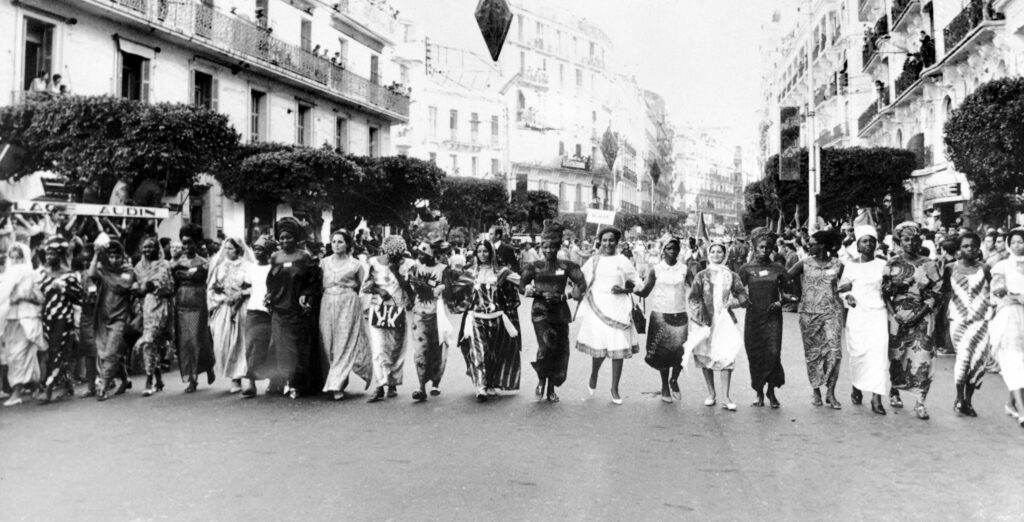Beyond Hyperpolitics

What comes after the populist upsurge of the 2010s, when opponents of the Euro-Atlantic liberal center broke into the seemingly impenetrable sphere of electoral politics? How should we define the settlement that is emerging in its wake? On the left, the horizon of radical social democracy has now receded: the establishment closed ranks against Corbyn and Sanders, thwarted the programs of Tsipras and Iglesias, and continues to demonize Mélenchon. On the right, neo-nationalists from Trump to Meloni to Le Pen have had considerably more success, entering the halls of power or establishing themselves as the dominant forces of opposition. But it remains unclear whether their ascent marks a paradigm shift that will dismantle the existing order, or simply a passing explosion of rage.
One of the most intriguing ways of conceptualizing the scorched landscape of the 2020s is the theory of ‘hyperpolitics’, advanced by the Belgian political philosopher Anton Jäger. Our current predicament, he writes, is one of “extreme politicization without political consequences.” While ideological commitment is ubiquitous, institutional outlets for it are absent. While contestation is fierce, the form it takes is frustratingly ephemeral. Politics is at once everywhere and nowhere – permeating our everyday lives but failing to influence state policy, which continues on much the same neoliberal trajectory, with minor variations here and there.
In his short book Hyperpolitik (2023), Jäger outlines this new cultural logic, starting with a periodization of its predecessors: the ‘mass politics’ that endured up until the 1980s, the “post-politics” that defined the 1990s and 2000s, and the “anti-politics” of the 2010s. Socialist mass politics, he writes, relied on collective organizations – trade unions and communist parties chief among them – which not only defended workers from exploitation, but also deflected the prejudices such as sexism or xenophobia that they may otherwise absorb from capitalist society. These were “total” institutions that forged a connection between the inner lives of their members and the outer world.
With the onset of the inflationary spiral in the 1970s, though, capital could only maintain its rate of return by smashing such “interest groups,” via a mixture of legal restrictions, market incentives, and blunt force. “The neoliberal state,” Jäger observes, was an “interventionist experiment to shield the market from mass democracy.” Under its rule, society gradually descended into a generalized stupor. Interpersonal life was mediated by digital technology rather than voluntary associations, the cult of consumption both centered and sapped the libido. The dead weight of “consensus” appeared to have terminated history itself.
The populist backlash of the 2010s briefly raised hopes of a political alternative, only to dash them in the latter half of the decade, as forces on both the right and left failed to meet popular expectations or deliver on their programs. Now, in its aftermath, the ideological climate continues to be shaped by major ructions, from the burning of police precincts to the January 6th riot, lockdown protests to Palestine marches. “The political” once again seems omnipresent. But this is nothing like the “superpoliticized” culture of the twentieth century, in which fascism and communism broke down bourgeois distinctions between public and private life, because neoliberalism has effectively closed down the avenues for collective agency. Without them, popular influence over government remains elusive. “The public sphere has been repoliticized and re-enchanted,” notes Jäger, “but on terms which are more individualistic and short-termist:” “an abidingly ‘low’ form of politics – low-cost, low-entry, low-duration, and all too often, low-value.” Across the spectrum, activism mimics the “fluidity and ephemerality of the online world,” with communities replaced by swarms of individuals, firm commitments by fleeting passions.
This comes alongside what Jäger describes as a shift in the relationship between state and market, with governments increasingly viewing themselves as large contracting outfits: funding companies to deliver threadbare services, repair infrastructure and manage crises under the auspices of “public-private partnership.” The realm of institutional power is dominated by this form of strong-state neoliberalism, which is largely impervious to external pressure. Jäger predicts that, in these conditions, periodic eruptions of popular anger will persist, but that they are likely to be little more than “postmodern renditions of ancien régime peasant uprisings: an oscillation between passivity and activity, yet one that rarely reduces the overall power differential within society.”
Jäger’s heuristic captures many aspects of the contemporary scene. Political conflict appears to have escalated and diffused across the social field without affecting concrete power relations. The liberal worldview, struggling to retain its hold on both the young and the old, is defended by the middle aged with greater vehemence – though typically in online forums rather than collective organizations. The gulf between public opinion and government policy is plain to see.

Yet like most theories that operate at this level of generality, “hyperpolitics” elides certain empirical details that may complicate our diagnosis. Among them are the structural differences between the far left and the far right, which are sometimes flattened out by Jäger’s depiction of an omnipotent establishment flanked on either side by ardent but impotent protesters. The examples of hyperpolitical activity he cites – Trumpism, Farageism, BLM, Extinction Rebellion – clearly reflect the fact that one political pole has been more electorally successful than the other. How does Jäger account for this disparity? Civil society is equally “disarticulated” on both ends of the spectrum, he claims, with the closure of Workingmen’s Associations mirrored by the waning of Conservative Clubs – yet this is “more of a problem on the left than on the right because the benchmarks of any successful socialist politics are always higher. To the right, the stabilization or preservation of property relations is mostly enough. Inertia and resignation, more than militancy, remain its great assets.”
On its own terms, this is a perfectly coherent explanation of the right’s political advantages: whereas the left must build a collective culture that defies the dominant one, the right can operate within the social field that capitalism spontaneously generates, giving the latter an inherent edge. But while this argument checks out on a macrohistorical level, it says little about the specific dynamics which have enabled the right’s political victories over the past decade. Nor does it explain the ideological content of its project, or the extent to which it can realize its aims in government. If we are to determine whether today’s far right really fits the “hyperpolitics” label, then, we must carefully consider each of these factors: its genealogy, its political outlook and its institutional strength.
For the Hungarian philosopher G.M. Tamás, the reactionary politics of the twenty-first century evolved out of the collapse of the Soviet bloc and the parallel erosion of the social-democratic state. As capitalism was naturalized as the sole unrivalled system, insulating itself against utopian critique, popular oversight over its coercive apparatuses was weakened, giving them greater freedom of action. This ‘decline of critical culture’ enabled the hollowing out of representative institutions. The state’s role was no longer to establish a social compact with the lower classes, nor even to oversee their exploitation, but simply to expel them from public life. What Tamás terms ‘post-fascism’ emerged as the agent of that expulsion. Neoliberalism led directly into hardline nationalism.
To this analysis, one could add that these two ideologies were always dialectically entwined As it removed obstacles to transnational capital and ripped apart the fabric of working-class life, neoliberalism also promoted an image of the nation – its particular character, ethos, virtues – designed to attract investors. People who failed to conform to this market-friendly paradigm were seen as legitimate targets for racialized repression: branded scroungers or delinquents, subjected to higher levels of state violence and surveillance. From the outset, globalization was conterminous with these modes of forced integration and exclusion. Today’s self-described ‘anti-globalists’ are merely seeking to extend them, in the hope of creating a more exclusionary national community.
The guiding political purpose of the far right today is thus, as Enzo Traverso writes, to restore the “juridical separation” between citoyens and indigènes, drawing on deep-rooted legacies of reaction in its different national contexts (British imperialism, American nativism, Italian fascism) in order to reinforce this boundary. If the neoliberal state has been sapped of its capacity, the aim of neo-nationalism is to re-empower it as a biopolitical agent: one which can sink its claws into the human body itself. Its raison d’être is ‘controlling population movements and internal migration and registering foreigners, criminals and subversives’: distinguishing between good and bad immigrants, productive and surplus workers, assimilable groups and alien ones. Far-right ‘identity politics’ is really a form of ‘identification politics’, through which these all-important classificatory distinctions can be upheld.
This far-right project does not always need to break with the existing constitutional order; it can instead rely on what Nikhil Pal Singh calls “zones of internal exclusion within liberal democratic societies,” from prisons to ghettos to migrant detention centers. It tends to use state power to expand these repressive enclaves without changing the broader political topography. While it claims to offer a communitarian alternative to liberal capitalism, its concrete policy platforms tend to belie this ambition. Even in the rare instances where the contemporary right offers material concessions like child benefits or pension rises – as with Poland’s Law and Justice party – it makes no attempt to reverse the atomizing tendencies of market society. In fact, it is more likely to accelerate them: think of Trump’s demolition of the public sector, Meloni’s privatization program, or Farage’s demands for further deregulation.
Does this therefore mean that the right’s bark is worse than its bite, that it offers more continuity than change, as Jäger seems to suggest? In effect, the answer comes down to whether it is capable of using its governing power to restrict the privileges of full citizenship, prioritize some identity groups over others, spread racial terror via state agents or vigilantes, and tighten authoritarian controls. The obstacles to this agenda are not insignificant. On various occasions, the institutions of the establishment – the courts, centrist parties, the media, big business – have stepped in to block it. This is because the political center fears that the far right’s attempt to enhance the biopolitical capacities of the state will undermine the ritual procedures (the certification of elections, the peaceful transfer of office or the separation of functions) which guarantee social stability. It likewise views the right’s incitement of popular passions as a threat to the sovereign authority of policymakers, and its economic clientelism as an affront to fiscal discipline. Such misalignments mean that the maximal ambitions of neo-nationalism are often frustrated.
Yet there are other situations in which these bastions of the status quo have proved entirely willing to assist the agents of reaction. For center-right parties whose links with their voter base have been increasingly strained, the best hope of political survival lies in an alliance with the far right – hence Spain’s Partido Popular propping itself up with Vox, Italy’s Christian Democrats supporting Meloni, the Republican establishment falling in line with Trump, and so on. The business class, too, has opted decisively for the far right over the far left, preferring the potentially disruptive impact of a Trump or a Le Pen to the redistributive policies of a Sanders or a Mélenchon. And the repressive apparatuses, from the courts to the police to border patrol, are in many cases already operating as an exclusionary ‘state within a state’, which will happily enforce a neo-nationalist program.
All this means that the right can in theory use elite institutions to advance its agenda: a luxury that is denied to the left. At mass level, meanwhile, the right’s biopolitical demands often strike a chord with those experiencing downward pressure on their social position. As class distinctions among the lower orders begin to dissolve under the impact of inflation and austerity, people look to the state to reassert them: protecting favored groups at the expense of marginal ones. Hard borders come to be seen as a necessary safeguard against the prospect of pauperization: not just a physical barrier, but a taxonomic instrument to enforce traditional hierarchies of race and gender. This downwardly-mobile constituency is not only numerically large enough to influence elections; it also has strong grassroots institutions through which it can pursue its political interests. The U.S. Tea Party, as has often been pointed out, was sustained by a sprawling network of churches, charitable groups, online forums, local libraries and homeowners’ associations – as well as being tied into the social base of the carceral state itself, as a sector that employs hundreds of thousands and boasts increasingly militant unions.
In this sense, Jäger’s description of hard-right mobilizations as “postmodern peasant uprisings” runs the risk of obscuring their complex relationship with society’s political architecture. By extension, it is liable to underrate their potential danger. Watching the Trump administration’s break-neck remaking of the federal government and ferocious clampdown on dissent, it would be difficult to characterize this as “extreme politicization without political consequences,” or an ineffectual politics of the swarm. A more clear-eyed way to describe it would be as an aggressive mode of “identification politics:” one which emerged naturally out of neoliberalism, which is viewed by many as a bulwark against its predations, and which is assisted by elite and popular institutions alike. These are surely the most proximate reasons for its success.
On the left, the disarticulation of civil society is surely more thoroughgoing than on the right; there is no equivalent Tea Party-style network capable of supporting an electoral movement at the national level. But this is not to say that it is comprehensive. Voluntary associations focused on a range of material issues – wages, living conditions, the environment, war, state violence – are still operating across the Western world, their ranks swelled by the tumult of the 2010s. The problem with this constellation of activist groups is not necessarily that it is too hyperpolitical, that is to say loose and disaggregated, with members joining on an “individualistic” basis and expecting “instant rewards.” On the contrary, the lack of easy victories for the left means that many of its organizers have become accustomed to the politics of the long march. Their sense of powerlessness in an age of escalating catastrophe often impels them to build institutions which can function as alternative lifeworlds: providing shelter from an intolerable system and defending against its cruelties. Migrant solidarity groups are under no illusions about their ability to outlaw immigration raids, but they can still block enforcement vans from entering their neighborhoods. Climate protesters cannot persuade the government to decommission pipelines, but they can sabotage them instead. Here, the absence of traditional mass politics does not lead directly into hyperpolitics. It gives rise to a politics of resistance – in which, precisely because the prospect of administering the state seems impossibly remote, it is all the more necessary to defend against it.
Whereas the hyperpolitics thesis envisions a future where both the left and the right have become unmoored from institutional life, such that politics is rendered fluid and ineffectual, the above analysis suggests a potentially different direction of travel – one that is simultaneously more and less hopeful. The nationalist right, already rooted in the institutional matrix of neoliberalism, will seek to tighten its grip on the state and mainstream civil society, hoping to radicalize or assimilate the political centre. The left, shut out of this matrix, will continue to build its own institutions on society’s margins in order to protect itself. These two institutional spheres will then be set on a collision course. At present, the odds are firmly in favour of the right. To rebalance them, the left will need to translate its politics of local resistance into a unified vehicle – or ‘total’ institution – capable of linking together its disparate spheres of struggle.
Oliver Eagleton is an editor at New Left Review and the author of The Starmer Project (2022). He writes regularly for the New Statesman and Jacobin.
